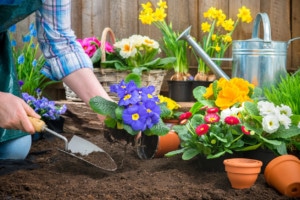It’s springtime! And that means a season of gardening and yard work is here. Although it can be therapeutic to be outside enjoying nature, it can take a toll on your body, especially your low back.
“When gardening, the majority of your movement takes place in a bent position and when prolonged, can lead to low back pain,” said Karen Turner-Schlegel, Physical Therapist in Encinitas.

As you plan out your new landscape, Karen has a message for you: Take care of your back!
“Repetitive bending, reaching, twisting and lifting – all actions common to gardening – tend to put the lower area of your back at risk.”
Gardening remains one of the most popular outdoor activities in the U.S., with the National Garden Association estimating that 40 million households plant and maintain gardens each year. To maximize the joy of gardening and maintaining a healthy lawn, Karen offers the following tips to help people avoid back pain and injury while enjoying the fruits of their labor:
Warm Up & Stretch: Think of gardening as a physical activity, not a leisurely hobby. As such, warm-up is required, a regimen consisting of simple exercises for stretching your quads, hip flexors and back. Also, don’t overlook the value of walking for unloading pressure from the spine.
Start Slow: Don’t tackle the tough jobs first. Karen suggests warming up your body and building stamina by starting with simpler projects and breaking larger projects into shorter gardening sessions.
Take Breaks: While in the yard and/or garden, take frequent breaks to walk around, hydrate and stretch. Every few minutes, stand and extend your spine in a backward bend in order to equalize pressure in the spine. If you know you’re going to be hunched over raking or pulling weeds, it helps to take breaks and put your hands on your hips and backward bend for a few reps.
Garden on Hands & Knees: When working close to the ground, do so on all fours and use a gardening pad for your knees. Better than bending at the waist, this gardening position places the least pressure on the spine – even better than kneeling or working from a seated position.
Practice Mindful Lifting: When lifting bags of fertilizer or heavy potted plants, always bend with the knees and lift with your legs, keeping the bulk of the weight close to your body.
Buy & Use Quality Tools: Karen suggests using quality, long-handled gardening tools to help reduce your need to bend at the waist. And don’t lift and carry when you have a wheelbarrow or garden cart available.
Listen to Your Body: If you begin to feel discomfort or pain in your spine, take a break, change tasks or stop your gardening task altogether. “Walk, stretch and rest your back,” Karen said. If pain or discomfort persists, contact Karen directly for a personal assessment of the back and spine.

